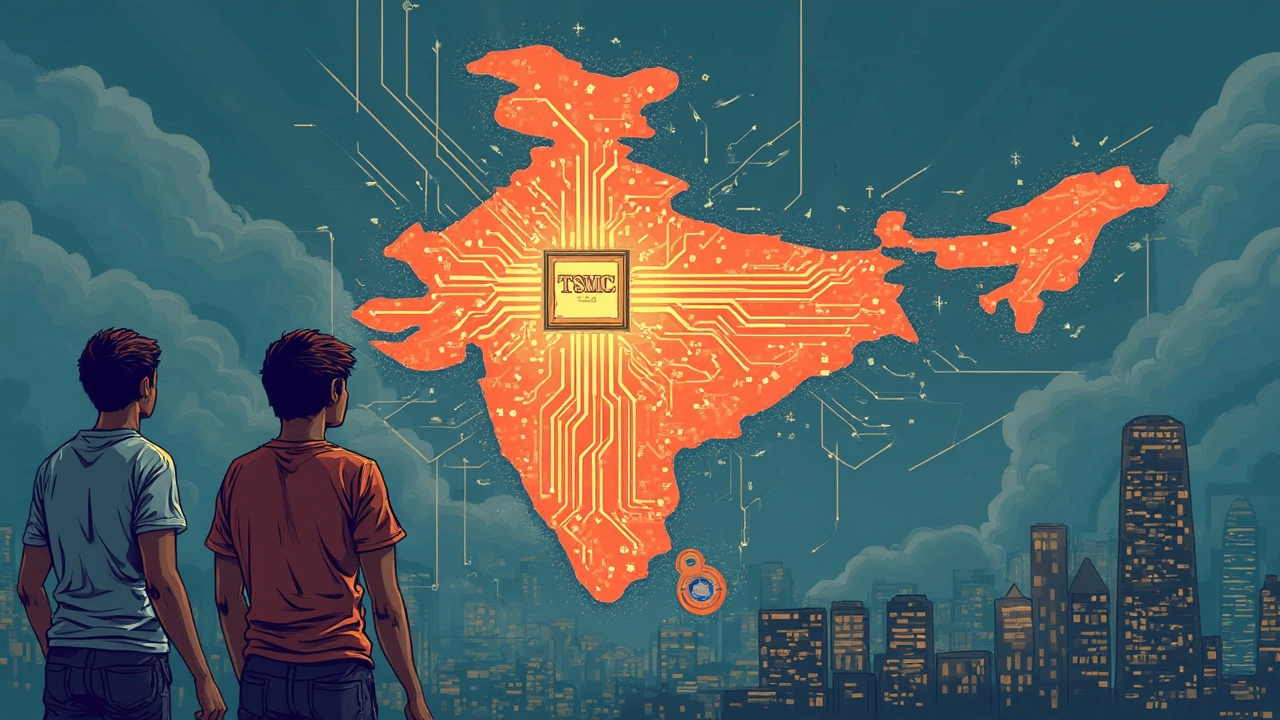Big chipmakers going global is not new, but every time a news alert pings about India missing out on a big investment, it stings. Just look at TSMC, the world’s leading semiconductor foundry—the one that powers Apple, NVIDIA, AMD, and a whole bunch of devices we use daily. Despite enormous incentives and a huge local demand for electronics, TSMC has given India a pretty wide berth. Why hasn’t India managed to land a deal with the chip giant? Spoiler: It’s not for the lack of trying. There are layers to this—and not all of them are obvious on the surface.
TSMC’s Global Footprint and What’s at Stake
Let’s set the stage: TSMC—short for Taiwan Semiconductor Manufacturing Company—makes most of the advanced chips that keep our modern lives humming. They’re not just big, they’re massive. In 2024, TSMC made about 60% of all contract chips worldwide. That's enough silicon to power pretty much every smartphone brand, tons of laptops, servers, and even AI chips that crunch the world’s data. TSMC’s biggest factories? They’re lined up in Taiwan, and recently, the company has gone global, building major fabs in the US (Arizona), Japan, and Germany. These aren't small moves. Each fab costs between $10 to $40 billion, and local governments bend over backwards with subsidies and perks.
Now, India’s government would love one of these megaprojects—and not just for bragging rights. Globally, chip demand is rising, and supply chain shocks have shown just how risky it is to depend on one region or supplier. India wants those jobs, the tech transfer, and the chance to finally compete in high-end electronics manufacturing. So, what’s stopping TSMC from setting up a state-of-the-art foundry in India?
India’s Big Pitch: What Went Right, What Went Wrong
India has not been sitting idle. In late 2021, the government rolled out the red carpet for chipmakers. We're talking $10 billion in direct subsidies, slashed red tape, speedier clearances, “single window” project approvals—the whole package. On paper, it's almost as sweet as the deals TSMC got in Japan or the US. The government even roped in states like Gujarat and Tamil Nadu to pitch suitable land, stable water supply, and reliable power—essentials for any fab.
Here's a lesser-known fact: India partnered with ISMC and Vedanta-Foxconn for major fab projects, hoping these alliances would attract TSMC or similar giants as technology partners. Some early conversations even took place between TSMC teams and Indian officials. Names like Micron and Applied Materials (big in chip packaging/TOOLS, not mass production like TSMC) did sign up for investments, but TSMC stayed on the sidelines. Why?
For all the ambition, India’s pitch faltered on execution. While it’s true that frameworks are improving, foreign chipmakers gripe about two key things: project timeline reliability and long-term policy stability. Chip manufacturing can’t risk sudden rule changes, water shortages, or grid failures—not for investments running up to $40 billion. State governments also tend to tussle over details, and regulations can get fuzzy when you’re trying to secure parcels of land big enough for a massive factory. In 2024, several investors in the ISMC and Vedanta projects pulled out, worried about delays and shifting rules. TSMC—already running at breakneck speed—doesn’t want to be the guinea pig.

TSMC’s Real Worries: Infrastructure, Talent, and Ecosystem Gaps
The direct cash on offer is attractive, but for a company like TSMC, it’s just one piece of the puzzle. You need bulletproof logistics, a support ecosystem, skilled engineers, and a network of suppliers who can deliver gas, chemicals, and components to the micron. TSMC's Arizona project tells a cautionary tale: even in the United States, they faced labor shortages, delays, and headaches sourcing specialty parts—leading to a year’s delay in mass production. The Japanese fab went much smoother because the ecosystem was ready, local suppliers could scale up fast, and there were plenty of trained engineers familiar with chipmaking at that bleeding-edge level.
Now, let’s look at India. Sure, India has a pool of talented software engineers, but chip design and manufacturing are worlds apart. Setting up a fab needs thousands of people who get how to run the “clean room” process, how to do micro-lithography, and how to spot defects at the nanoscale. In 2023, a report by Deloitte pointed out that India would need to train upwards of 20,000 specialized chip engineers, and the country was producing less than 1,500 with hands-on fab experience per year. That’s a huge gap. Without a supply chain and trained workforce, TSMC would be left ferrying foreign experts for years—which slows everything down and adds to costs.
Even support industries aren’t up to TSMC’s standards yet. A fab isn’t just one big building—it’s surrounded by dozens of specialist suppliers, trucking outfits, and quick-response service teams for emergencies. For instance, the availability of “ultra-pure” water (we’re talking water filtered a thousand times more than what you’d get out of a hospital tap) is still patchy in Indian industrial zones. Stable power grids? Better than before, but outages do occur, and chipmaking cannot tolerate a blip lasting even a split second. Takeaway: TSMC will not move into a greenfield site unless every single piece of the puzzle is tight from Day One.
The China Factor and Geopolitical Calculations
No discussion about TSMC's strategy is complete without China. Chip manufacturing has become a geopolitical chess game. The United States, Japan, and Europe are bending over backwards for TSMC because they want to break their own dependence on Chinese supply chains. India’s growing tensions with China, and its market potential, give it the strategic edge. So why isn’t TSMC biting?
TSMC won’t say this out loud, but there are risks they’re probably weighing: If you set up shop in India, do you risk angering China, which remains both a massive market and a manufacturing hub for global gadgets? Could doing business in India mean facing headaches with Chinese suppliers or missing out on joint projects? TSMC is extremely protective of its intellectual property—its chipmaking tech is the crown jewel of the global tech economy. The company feels more comfortable with “known partners,” and nations that have robust IP laws and a stable history of protecting foreign investment. India, to its credit, has been modernizing these frameworks, but there’s still wariness among foreign giants, thanks to a handful of high-profile IP lawsuits and patent disputes dragging through Indian courts for a decade.
Plus, let’s be honest—Taiwan itself has its own difficult spot between China and the US. TSMC, as Taiwan’s tech crown jewel, is not just a corporation. It’s a strategic asset in a global political game. Before making a multibillion-dollar commitment, the company wants a very calm, predictable, and “low headline” location for its next big move. For now, India’s promise just seems a little too wild-card for their taste—especially when they can find more convenient or battle-tested options in Japan or Europe.

What India Could Do Next—and Why the Stakes Remain High
It’s not all doom and gloom. India’s ambition to become a chip hub is not going away. The country's recent wins with companies like Micron (which is building a big memory packaging plant in Gujarat) signal that things are improving. Government think tanks have pushed for “handholding”—pairing up Indian startups and research groups with global chip leaders for R&D and training, instead of simply tossing cash at multinationals.
Here’s a practical tip: If India wants to woo a giant like TSMC, it needs to focus on filling the real gaps—training tens of thousands of chip engineers, building up local supply chains, and guaranteeing bulletproof infrastructure. Bangalore’s software boom came about not only from incentives, but from bet-the-farm investments in education and urban infrastructure. Now, the same needs to happen for hardware. The government could set up public-private partnerships to fund “chip academies,” lure Indian chip experts abroad back home, and give major tax breaks to any company that supplies specialist chemicals or components. TSMC doesn’t need more government press conferences or handshakes for the cameras. It needs to see water on tap, power that never glitches, and a supply chain that can flex at a moment’s notice.
The stakes? Huge. If India manages to land a TSMC fab—or even a significant partnership with leading chipmakers—it’ll flip the table on the global tech scene. The “chip wars” of the 2020s have shown that national security, jobs, and economic resilience all flow through those tiny wafers of silicon. Missing out means staying stuck as an importer, always paying premiums for the latest chips, unable to truly control your own digital future.
So, when will TSMC make its move? Only when India turns promises into reality on the ground, not just in pitches. Until then, TSMC will keep making waves in Arizona, Kumamoto, and Dresden, while India watches—and waits for its chip moment to finally arrive.






